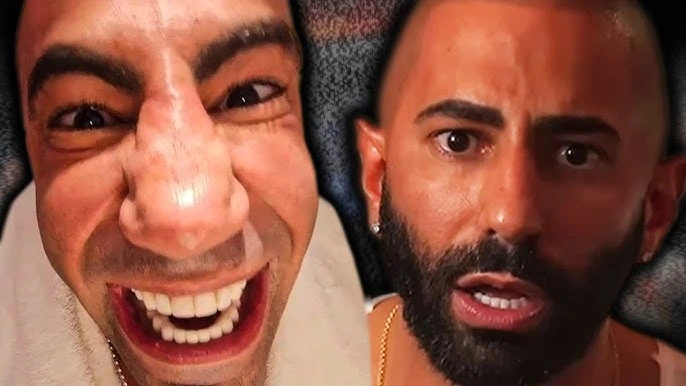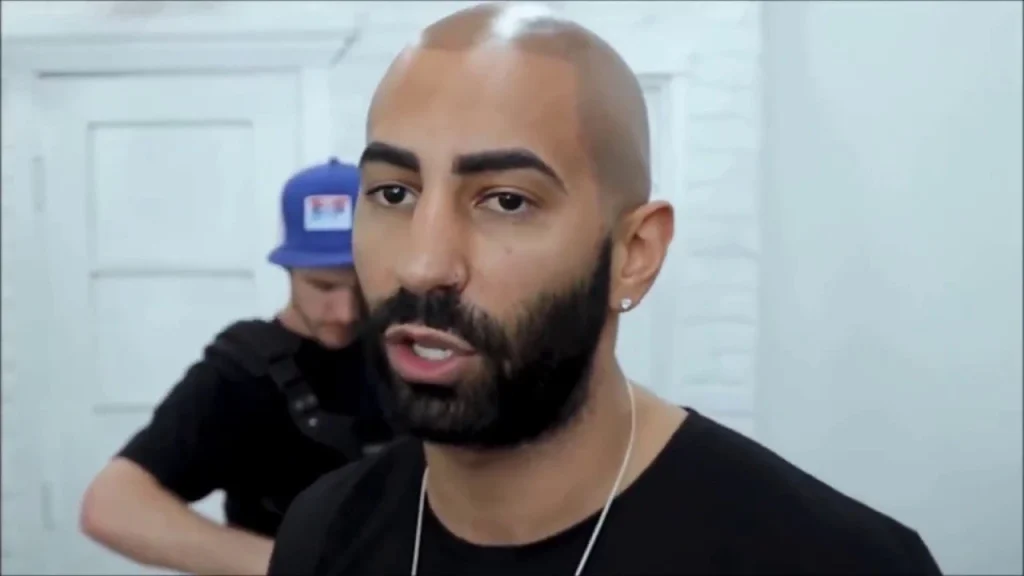
In the vast universe of online fame, few creators have ever burned as brightly—or as chaotically—as FouseyTube, real name Yousef Erakat. For over a decade, he’s been one of YouTube’s most unpredictable stars. From his rise as a comedic prankster to his collapse live on stream, his career has been an emotional rollercoaster that defines the modern creator age.
But his final livestream wasn’t just another internet stunt. It was something raw, uncomfortable, and unforgettable—part performance, part confession, part tragedy.
This is the complete story of how it all spiraled—how fame consumed one of YouTube’s most electric personalities before millions of eyes.
The Meteoric Rise of FouseyTube: From Comedy to Chaos
Before the madness of his final broadcast, FouseyTube was a dreamer. Born and raised in California to Palestinian parents, Yousef Erakat started his channel in 2011, like many early YouTubers—young, ambitious, and hungry to be seen.
His channel initially focused on funny sketches, prank videos, and social experiments, the kind of content that ruled YouTube’s golden era. Within a few years, FouseyTube became a household name in the platform’s comedy space.
But what made him stand out wasn’t just humor—it was emotion. He connected deeply with fans, spoke openly about insecurities, and shared motivational talks that felt raw and real. Audiences saw not just a comedian, but a man searching for meaning through the lens of fame.
Yet, success came with pressure. And pressure, for Fousey, became fuel—and poison.
Fame’s Shadow: Cracks Begin to Show
Fousey’s energy was unmatched. He was loud, spontaneous, and often manic in tone. Over time, though, his high-energy persona began to show cracks. The internet started noticing signs of emotional exhaustion.
He’d vanish for months, then return with emotional monologues about faith, happiness, and self-love. He would declare “rebirths,” delete old videos, then post new ones promising change. Each return became bigger and stranger than the last.
Behind the scenes, his mental health struggles—particularly depression and bipolar episodes—began seeping into his public persona. And as his fame grew, so did the expectation to stay entertaining, positive, and relevant.
But fame doesn’t forgive exhaustion. The very audience that once lifted him up began turning against him when his behavior became erratic.
The Build-Up: A Man on the Edge
In the months leading up to the final livestream, FouseyTube’s online presence became increasingly unstable. His videos and streams turned more unpredictable, more personal, more chaotic.
He clashed publicly with fellow influencers, called out critics, and began making grand, messianic claims about his purpose online. He often referred to himself as “chosen by God to inspire change.”
At first, fans thought it was motivation. But soon, it felt like a man losing his grip on reality—broadcasting his unraveling in real-time.
Patterns of Volatility
- Extreme mood swings during streams
- Long, emotional rants about betrayal and destiny
- Confrontations with other creators and fans
- Claims that “everything is part of a bigger plan”
By now, many were concerned. Others simply tuned in for the spectacle. And Fousey, as always, kept feeding the audience what they wanted—drama.

The Final Livestream: The Night Everything Collapsed
Then came the night that would define his career forever—the final livestream.
It began like any other Fousey stream: loud music, chaotic energy, and promises of “truth.” Thousands tuned in. But within minutes, something felt off.
Hour 1: The Grand Entrance
He appeared jittery and intense, pacing, rambling about destiny, haters, and divine signs. His tone shifted wildly—from joy to tears, from confidence to despair. At times, he seemed detached from reality.
Hour 2: The Spiral
The conversation grew darker. He accused unseen enemies of trying to destroy him. He spoke to the camera as if it were alive, pleading for understanding. His team tried calming him, but he refused.
Hour 3: The Breaking Point
Then came chaos. He received a call—viewers couldn’t tell if it was real. His emotions exploded. He shouted, cried, and repeated phrases like “They’re coming for me” and “I need help.”
Moments later, he appeared to call emergency services live. Viewers watched in confusion as his panic grew. It was raw, painful, unfiltered humanity.
The End: Silence
The stream abruptly cut off. No outro. No explanation. Just darkness.
And for millions watching, that silence was haunting.
The Aftermath: Internet in Shock
The internet exploded overnight. Clips of the stream flooded TikTok, YouTube, and Reddit. Fans and critics alike debated what they had just witnessed.
Was it a breakdown? A performance? A desperate cry for help?
Reactions Flooded In
- Some fans expressed heartbreak, calling it “the saddest thing I’ve ever seen.”
- Others accused him of staging everything for attention.
- Mental health advocates called for compassion and support rather than ridicule.
But one thing was certain: the FouseyTube we knew was gone.
For days after, his accounts went silent. Rumors spread that he had been hospitalized, while others claimed he was stepping away from the internet permanently. Whether by choice or by necessity, Yousef vanished.
Behind the Mask: The Psychology of a Public Breakdown
What drives a creator to implode live in front of millions? To understand that, we must look deeper at the pressures of online fame.
Fousey’s career is the perfect storm of addiction to validation, performance fatigue, and mental health neglect.
Validation Addiction
Every like, view, and comment feeds dopamine. Over years, that feedback loop becomes a dependency. The audience isn’t just watching—you’re surviving through their attention.
Performance Burnout
He built his fame on energy and authenticity. But the more he tried to stay “real,” the less real he became. Every breakdown turned into content, every confession into entertainment.
Public Mental Health Struggle
Unlike traditional celebrities, online creators can’t hide. Their lives, emotions, and breakdowns are public domain. And for someone like Fousey, whose identity was tied to being “transparent,” that vulnerability became his undoing.
The Internet’s Role: When Audiences Become Voyeurs
What happened during FouseyTube’s final livestream is bigger than one man—it’s a reflection of how modern audiences consume pain.
The digital world doesn’t blink. Every second of suffering becomes content, dissected and memed in real time.
When Fousey cried on camera, viewers spammed emojis. When he begged for help, chat exploded with “L” reactions. It’s not cruelty—it’s numbness. The internet has trained us to see emotional collapse as spectacle.
And that’s the real tragedy: no one turned off the stream.
The Creator Crisis: Fame Without Boundaries
Fousey’s story is a cautionary tale for all creators chasing fame.
No Privacy
Every thought, every argument, every mistake can go viral. There’s no safe space for creators to fail privately anymore.
No Authentic Breaks
When you turn your life into content, breaks feel like death. You disappear, the algorithm punishes you, and you lose relevance.
No Support Systems
Many creators operate without professional help—no therapists, no managers trained in crisis response. The result? Emotional implosions livestreamed for millions.
Lessons from FouseyTube’s Fall
Lesson 1: Fame Isn’t Freedom
It’s a cage with invisible bars. The higher you climb, the less you can breathe. Fousey’s breakdown wasn’t a random collapse—it was the inevitable outcome of years trapped in a system that rewards extremes.
Lesson 2: Mental Health Must Come First
Creators need structured help—therapy, boundaries, recovery time. There’s no glory in self-destruction for views.
Lesson 3: Audiences Have Responsibility
We must stop treating breakdowns as entertainment. Viewers aren’t just spectators—they’re participants. The collective gaze can heal or destroy.
Lesson 4: Platforms Must Protect Creators
Streaming platforms profit from chaos. They have the data, the power, and the responsibility to intervene when a broadcast clearly turns into a mental health emergency.
The Silence After the Storm
Weeks after his final stream, Fousey resurfaced briefly—quieter, humbler, almost unrecognizable. He thanked fans for support and promised to focus on his health. Then, once again, he disappeared.
The silence that followed felt peaceful—and painful. For the first time, Yousef wasn’t performing.
His absence left a void in the creator community—a reminder that behind every camera is a human being with limits.
Why His Final Livestream Still Matters
FouseyTube’s breakdown wasn’t just one man’s tragedy—it was a mirror reflecting the dark side of the influencer era.
It showed how quickly fame can become isolation, how easily an audience can turn cruel, and how little support exists for the people who entertain us daily.
It forced millions to confront uncomfortable questions:
- Why do we watch people crumble?
- When does entertainment become exploitation?
- Can authenticity survive in a system that monetizes pain?
These questions linger long after the livestream ended.

The Legacy of FouseyTube
Despite the controversies, one cannot deny Fousey’s impact. He pioneered emotional storytelling on YouTube. He blurred the lines between reality and performance long before “IRL streaming” became a trend.
He inspired countless young creators to be open about mental health and identity, even if his journey became a cautionary tale.
Today, his legacy stands as a paradox—both a warning and an inspiration.
A Warning
Fame without grounding can destroy. The pursuit of virality at any cost can leave nothing but emptiness.
An Inspiration
Even at his lowest, Fousey’s vulnerability resonated. It reminded audiences that everyone—no matter how loud or confident—has battles unseen.
What We Can Learn from the Collapse
If there’s a moral in this tragedy, it’s not about failure—it’s about recognition.
We live in a time when fame is instant, global, and addictive. Yet, our humanity hasn’t evolved to handle it.
Creators Must Set Boundaries
Learn when to log off. Learn that silence doesn’t mean failure.
Fans Must Be Empathetic
Behind every meltdown is pain. Behind every “crazy moment” is a person crying for help.
Platforms Must Intervene
Algorithms shouldn’t reward distress. When millions watch a breakdown, someone at the top must act responsibly.
The Human Behind the Camera
Beneath the chaos, FouseyTube’s story is simply that of a man searching for love and purpose. He wanted connection—real, unconditional connection—and found instead an audience that applauded his pain.
He didn’t want to die famous; he wanted to live.
And that’s why his story cuts so deep. Because it isn’t just about him—it’s about us.

Conclusion: The Night the Internet Stopped Laughing
When FouseyTube’s final livestream ended, it wasn’t just the end of a broadcast—it was the end of an illusion.
For years, we believed creators could bare their souls endlessly without consequence. But that night proved otherwise. We saw, in real time, what happens when fame meets fragility.
It wasn’t entertainment. It was exposure.
It wasn’t a finale. It was a cry for help.
And in that moment, millions of people finally understood: behind the ring light, the brand deals, the views, there’s just a human being trying to hold it together.
Final Thoughts
FouseyTube’s last livestream is destined to remain one of the most haunting moments in YouTube history—a digital breakdown that revealed the hidden cost of constant visibility.
It forces a question every creator—and every viewer—must ask:
When the camera never stops rolling, who’s really in control?


